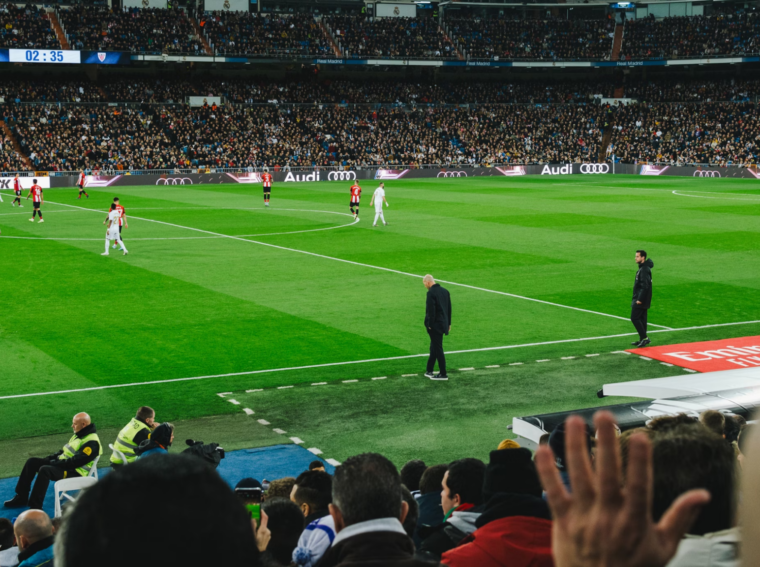Football has always been changing, and the “False 9” position has developed attacking tactics since its inception. This variation, which became more widespread in recent decades, shifts the perfect striker ideal to a more flexible forward who plays between center and midfield instead. The end product is a system that causes chaos in opponent backlines, opens up space, and requires flexibility. Now, let us deal with the development of this position, its roles, and its influence on contemporary soccer.
The Origins of the False 9
In the 1950s era of Hungary’s “Mighty Magyars,” a player by the name of Nándor Hidegkuti showcased elements of what could be regarded as the False 9. Nontraditional runs from Nándor Hidegkuti allowed the defenders to be pulled out of position and thus created space for his teammates to run into. Fast-forward a few decades, and the role was seen again at AS Roma, this time featuring Francesco Totti.
The role of the False 9 was made known to the world by Barcelona under Pep Guardiola, with Lionel Messi arguably the best to play the role. The system of Pep Guardiola stressed how a deep-lying forward could penetrate a well-organized backline while being able to create plays. The novelty proved to be groundbreaking, as it urged coaches all over the globe to consider other ways of using strikers. Also, the impact of this tactic has forced fans on online betting sites to reconsider their vision. After all, it was now necessary to reconsider the previous methods of analyzing the game and study how teams use this role. No one will argue that it has had a very big influence on modern football, even decades after its appearance.
The Role’s Core Mechanics
Focusing purely on the concept, False 9 requires intelligence, technical ability, and versatility on the field. Unlike a conventional striker, False 9s move back to midfield, causing the defenders to follow them. This leaves room for wingers and attacking midfielders to capitalize on such situations when facing a team. The positioning of False 9s means that players occupy the liminal area somewhere between a forward and a playmaker.

However, as with most roles, the success of the role strongly relies on coordination. If teammates are not ready for this tactic and the movement of the False 9, the attack motion becomes rigid. The teams that apply this system must have highly skilled and tactically disciplined players who are aware of the positional changes. Therefore, the application of the role is both risky and rewarding.
Four Defining Traits of a False 9
Certain qualities measure the effectiveness of a False 9 player. Let us look at these qualities one by one:
- Skill: One is required to have good ball control and precise passing to be able to link play.
- Perception: The player’s ability to know when to drop deep and push can become an unpredictable factor.
- Imagination: A False 9 aims to create and find spaces by playing in a unique way.
- Offensive Ability: Although there is more emphasis placed on the role deeper in the pitch, contributing may still require scoring, which adds more unpredictability to their game.
These sets of characteristics turn False 9 into a position that combines craft and football tactics into one of the most difficult positions in football. And if you want to learn even more interesting facts about the world of football, subscribe to MelBet Insta Bangladesh. The most interesting news from the world of sports is published there, which will allow you to be the first to know everything that is happening. And funny memes will definitely not let you get bored.
Applying the Concept of the False 9 Today
As modern football becomes more advanced, so does the role of the False 9 position. This is often used by coaches to counter teams with a stronger buildup play. A case in point is Liverpool’s Roberto Firmino, who has similarly turned it into an art form, as he is able to help in the build-up, too. His effectiveness in tracking the ball, assisting it, and scoring showcases his versatility.
However, this is hardly universal. Sometimes, a true center forward may be more effective than a False 9, such as when a game is more physical or when crossing the ball is dominant. In this regard, a careful analysis of the rival is needed, as well as modifying the style of play for the correct use of False 9.
The False 9’s Tactical Challenges
True to form, the False 9 position also has its hurdles. For example, the goal tally associated with the position can be reduced if the opponents place a man marker on the False 9, and the holder of the position does not counter that by advancing in central areas.

Additionally, there is a concern for tactical rigidity if the bluffer gets shut down in the eye of the game.
Lastly, it is not so simple to switch to this role. Players need to have specific drills in them, such as positional rotation drills. Other than that, the players need to have a good understanding amongst themselves. For that purpose, teams will have to depend on specific formations to maintain fluency in their attacks.
The Legacy of the False 9
The False 9 has changed the world of soccer as we know it today since now it is easier to show that an agile and skillful player can outplay a strong and tall one. It has shaped one’s vision throughout the years, forcing everyone to be creative and able to play in any position required. Starting from the greatness that Messi had in Barcelona to the magician that Totti had in Rome, the position has been present in the greatest highlights of all time.
Its inheritance is its versatility, be it piercing through defenders or altering the perception of how advances are made. As time goes on and technologies advance, tactics will change as well, but False 9 will always be an integral aspect of the game.
